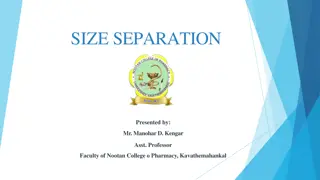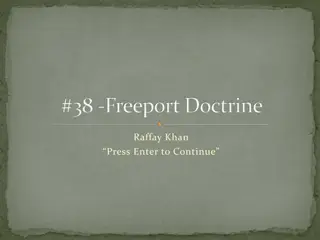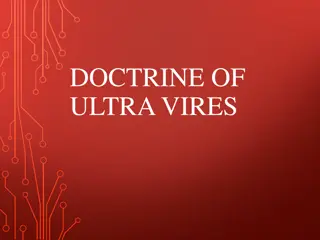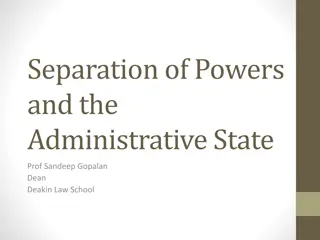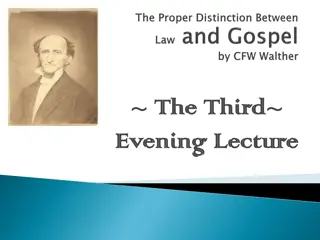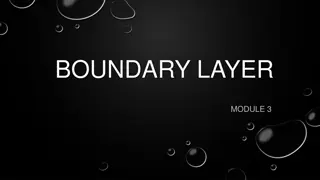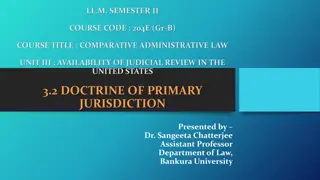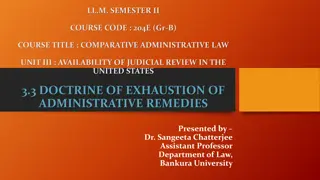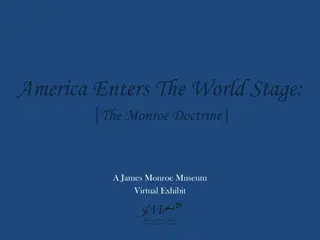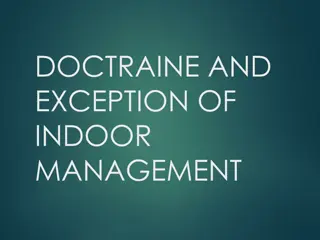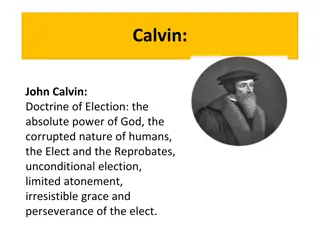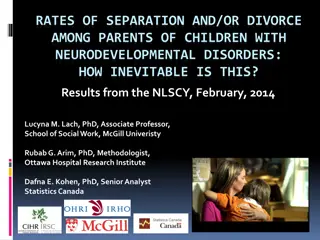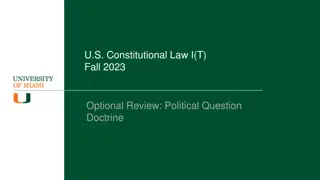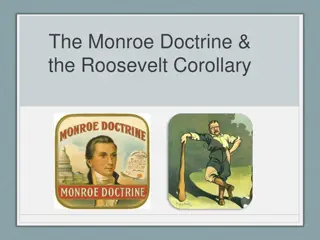Understanding the Doctrine of Separation of Power by Dr. Prabodh Kumar Garg
The doctrine of separation of power, as elucidated by Dr. Prabodh Kumar Garg, emphasizes the distinct roles of the executive, legislative, and judiciary branches to maintain checks and balances in governance. Originated by Montesquieu, this principle safeguards against tyranny and ensures liberty by preventing the concentration of power in a single entity. In India, the three organs of government function independently to uphold the rule of law and prevent interference between branches, thereby reducing the likelihood of abuse of power and corruption.
Download Presentation

Please find below an Image/Link to download the presentation.
The content on the website is provided AS IS for your information and personal use only. It may not be sold, licensed, or shared on other websites without obtaining consent from the author. Download presentation by click this link. If you encounter any issues during the download, it is possible that the publisher has removed the file from their server.
E N D
Presentation Transcript
Doctrine of separation of power By- Dr. Prabodh Kumar Garg Assistant Professor Department of Law Shia P g College Lucknow
The doctrine of separation of power is known to us by Montesquieu as he gave an absolute status and difference between the functions and powers of- the executive, the legislature and the judiciary.
According to Montesquieu By separating the functions of the executive, legislative government, one may operate as a balance against another and, thus, power should be a check on power. and judicial departments of
According to his views When the legislative and executive powers are united in the same person or in the same body of magistrates, there can be no liberty, because apprehensions may arise, lest the same Monarch or Senate should exact tyrannical laws, to execute them in tyrannical manner. Again, there is no liberty if the judicial power be not separated from the legislative and the executive.
Where it joined with the legislative, the life and liberty of the subject would be exposed to arbitrary control; for the judge would be then a legislator. Where it joined to the executive power, the judge might behave with violence and oppression.
In India We have three organs to function properly as below: - Legislative- to make the Law Executive -to implement the law Judiciary-to interpret the Law
State is divided into three different branches- legislative, executive and judiciary each having different independent power and responsibility on them so that one branch may not interfere with the working of the others two branches.
If this principle is not followed then there will be more chances of misuse of power and corruption If this doctrine is followed then there will be less chance of enacting a tyrannical law as they will know that it will be checked by another branch.
Theory of separation of power signifies the following three different things: - That the same person should not from part of more then one of the three organs of the government. That one organ of the government should not interfere with any other organs of the government. That one organ of the government should not exercise the functions assigned to any other organ.
There were primarily two reasons for non-insertion of separation of powers in the constitution: It was felt that it was too late to make amends as the constitution was already drafted and bringing the amendment inserting the principle of separation of powers would bring in change to the structure of the constitution. Since, British system of parliamentary form of government was adopted, it was thought it would be better to avoid adopting complete separation of powers as in the American system.
Doctrine of separation of power and Indian constitution
Some of the articles in the Indian constitution which emphasizes the separation of powers are the following: Article 50-Article 50 puts an obligation over the state to separate the judiciary from the executive. However, Article 50 falls under the Directive Principles of State policy (DPSP) and hence is not enforceable.
Articles 121 and 211-The legislatures cannot discuss the conduct of a judge of the High Court or Supreme Court. They can do so only in matters of impeachment.
Articles 122 and 212-The courts cannot inquire the validity of the proceedings of the legislatures. Article 361-The President and Governors enjoy immunity from court proceedings.
Check and Balance: - The doctrine of separation of powers is a part of the basic structure specifically mentioned in it. Hence, no law and amendment can be passed violating it. The system of checks and balances is essential for the proper functioning of three organs of the government. Different organs of the state impose checks and balances on the other. of the Indian Constitution even though it is not
The following examples illustrate the checks and balances: Judiciary exercises judicial review over legislative and executive actions. Judiciary has the power to void laws passed by the Parliament. Similarly, it can declare the unconstitutional executive actions as void. Legislatures review the functioning of the executive. Executive appoints the judges.
Legislative branch removes the judges. It can also alter the basis of the judgment while adhering to the constitutional limitation. Checks and balances act in such a way that no organ of the state becomes too powerful. The constitution of India makes sure that the discretionary power bestowed upon any organ of the state does not breach the principles of democracy. For instance, the legislature can impeach judges but as per the condition i.e. two third majority
Ram Jawaya v. Punjab (AIR 1955 SC 549) In India, we follow a separation of functions and not of powers. And hence, we don t abide by the principle in its rigidity. An example of it can be seen in the exercise of functions by the Cabinet ministers, who exercise both legislative and executive functions. Art.74 (1) wins them an upper hand over the executive by making their aid and advice mandatory for the formal head. The executive, thus, is derived from the legislature and is dependent on it, for its legitimacy.
Indira Nehru Gandhi v. Raj Narain (AIR 1975 SC 2299.) where the dispute regarding P.M election was pending before the Supreme Court, it was held that adjudication of a specific dispute is a judicial function which parliament, even under constitutional amending power, cannot exercise. So, the main ground on which the amendment was held ultra-vires was that when the constituent body declared that the election of P.M won t be void, it discharged a judicial function which according to the principle of separation it shouldn t have done.
Keshvanand Bharti Vs State of Kerla (1973) In this case, it was held that the Parliament couldn t amend the provision in such a way that violated the basic structure. And if it is made in violation of basic structure then such amendment will be declared as unconstitutional null and void.
Swaran Singh case (1998) The Supreme Court declared the Governor s pardon of a convict unconstitutional.
Conclusion The doctrine of separation of powers cannot be practiced in its classical sense, but it is being used with checks and balances according to the constitution of the respective nation. There is no strict separation of powers but the functions of the different branches of the government have been sufficiently differentiated. As the doctrine of separation of powers is not codified in the constitution, there is a necessity that each pillar of the State to evolve a healthy trend that respects the powers and responsibilities of other organs of the government.
Source/credit: - Books: - Lectures on Administrative Law by C. K. Takwani Lectures on Administrative Law by Dr. Rega Surya Rao Prashasnik Vidhi by U.P.D. Kesri Prashasnik Vidhi by J.J.R.Upadhyay Prashasnik Vidhi by K.C.Joshi
Websites: - www.legalbites.in http://persmin.gov.in www.docsity.com www.academia.edu www.ajol.info https://guides.libraries.uc.edu http://studymaterial.unipune.ac.in https://blog.ipleaders.in https://www.lawethiopia.com https://www.lexisnexis.com https://www.lawfinderlive.com https://biotech.law.lsu.edu www.Legalserviceindia.com






